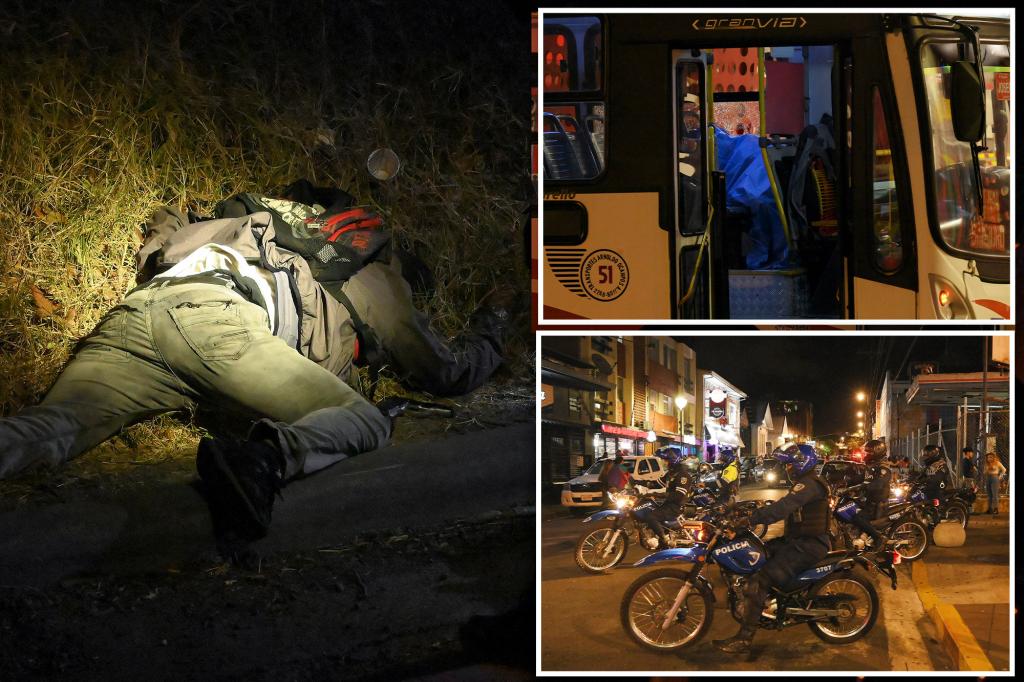Costa Rica, known for its rich ecosystems and easygoing slogan of the “pure life,” is now besieged by drug killings thanks to its increasing role in the warehousing and shipping of cocaine.
The Central American country logged 657 homicides in 2022 — the highest number of killings recorded there since at least 1990.
The grim tally reflects a disturbing trend that has been ticking upward for the past 15 years, statistics show.
Last year’s deadly violence was centered in the country’s Caribbean port city of Limon, which had a murder rate that was five times higher than the rest of the country of 5 million, officials said.
Authorities found that 65 to 80% of the local murders were believed to be “score settling” for grievances tied to the drug market — which has used everything from pineapples to yuca to stuff coke into and smuggle out of the country.
The influx of drug crime in the region has had President Rodrigo Chaves and his security ministers scrambling for answers to combat it.
Costa Rico was once just a pass-through destination for cartels who transported coke from Colombia to Mexico and the US, a dynamic that has shifted in recent years as homegrown smuggling gangs set up shop and use local ports to ship the narcotic to Europe.

The shift started after cartels began paying Costa Rican fishermen in cocaine in exchange for gasoline for their smuggling boats.
Martín Arias, the deputy security minister and head of Costa Rica’s Coast Guard, said the Mexican narcos decided, “We’re not going to use money; we’re not going to leave the trail that money leaves in banks, in systems; we’re going to pay in cocaine.”
Cocaine is relatively inexpensive in Costa Rica, and once the fisherman realized the value of the product was far higher overseas, they began to smuggle it out of the port themselves.
A ring that was dismantled in January found that smugglers had secreted coke into walls of steel containers and packed the drug among pineapple and yucca headed for Spain and The Netherlands.
Competition for market share of marijuana being shipped from Jamaica and Colombia also has added to the turf-war violence.
“We used to talk about Colombian cartels, Mexican cartels,” former Security Minister Gustavo Mata said.
But now gangs led by Costa Ricans are a leading cause of bloodshed in the tropical tourism destination as they control “enormous warehouses” of cocaine, he said.
“In Limon, there are four strong criminal groups competing for the drug market,” said Randall Zúñiga, director of Costa Rica’s Judicial Investigation Department. These groups clash, and “generally the people who die are sellers or members of the criminal groups.”

The violence has largely affected young unemployed men who turned to the drug trade after 7,000 port jobs were lost in a 2018 privatization foreign contract.
“If there are no jobs, it sounds terrible to say, but for many, the closest thing to a job is being a hit man,” said Antonio Wells, secretary general of the dockworkers union for Costa Rica’s Atlantic ports.
“In Limon, there are four strong criminal groups competing for the drug market,” said Randall Zúñiga, director of Costa Rica’s Judicial Investigation Department. These groups clash, and “generally the people who die are sellers or members of the criminal groups.”
The drug violence has had tragic collateral damage.
On Feb. 28, an 8-year-old boy was killed by stray bullet as he slept in San Jose. A 15-year-old was later arrested for the gang-war shooting, which Chaves labeled “outrageous, inexplicable and unacceptable.”
Security Minister Jorge Torres told national lawmakers in January that he would have a new security strategy in place by the summer.

He blasted the Costa Rican court system for allowing drug convicts to be released after serving only a fraction of their sentences and said more cops are needed.
“There are crimes for which you must serve the entire sentence,” Torres said.
“If we want to resolve this in the short term, we need more police in the streets,” he added.
Costa Rica’s murder rate is now 12.6 per 100,000 residents — about twice as violent as the US rate but a third of the rate in Honduras, which is due north of bordering Nicaragua, according to UN statistics.
“This isn’t the Limon I grew up in,” a retiree named David said as he sat in the city’s central square. “After 9 o’clock at night, you can’t walk, and it’s really sad.”
With AP
𝗖𝗿𝗲𝗱𝗶𝘁𝘀, 𝗖𝗼𝗽𝘆𝗿𝗶𝗴𝗵𝘁 & 𝗖𝗼𝘂𝗿𝘁𝗲𝘀𝘆: nypost.com
𝗙𝗼𝗿 𝗮𝗻𝘆 𝗰𝗼𝗺𝗽𝗹𝗮𝗶𝗻𝘁𝘀 𝗿𝗲𝗴𝗮𝗿𝗱𝗶𝗻𝗴 𝗗𝗠𝗖𝗔,
𝗣𝗹𝗲𝗮𝘀𝗲 𝘀𝗲𝗻𝗱 𝘂𝘀 𝗮𝗻 𝗲𝗺𝗮𝗶𝗹 𝗮𝘁 dmca@enspirers.com


